The toughest job in NASCAR? Maybe it's just figuring out which way this sport is heading
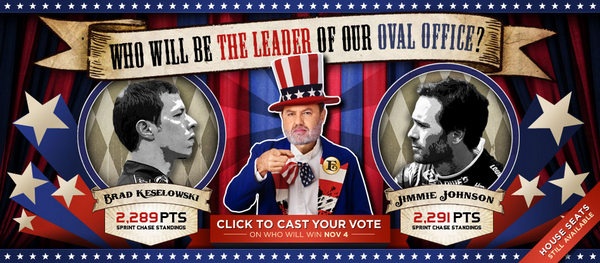
NASCAR's zaniest promoter: Texas' Eddie Gossage
(Updated)
By Mike Mulhern
mikemulhern.net
FORT WORTH
The toughest job in NASCAR?
Clay Campbell has it.
So does Eddie Gossage.
So does Talladega's Grant Lynch, and Charlotte's Marcus Smith, and Bristol's Jerry Caldwell, and Dover's Denis McGlynn, and New Hampshire's Jerry Gappens, and Richmond's Dennis Bickmeier, and Atlanta's Ed Clark, and Watkins Glen's Michael Printup....and all the rest of that battle-hardened gang of stock car racing promoters.
Selling NASCAR racing.
Like tickets and fans.
Fill them grandstands.
The economy hasn't made their job any easier, certainly.
But then the epidemic of no-caution racing and gas mileage finishes, and the too-business-like drivers, oh-so politically correct, and the loss of jaded sponsors aren't helping things either.
So Phoenix' Bryan Sperber must be doing something right: he just announced a sellout for next weekend's Phoenix 500.
Of course that's only 50,000 grandstand seats, according to NASCAR, but it's apparently the first sellout of the year. Phoenix, like many tracks, has been cutting seats, as demand declines; at one point Phoenix had nearly 80,000 seats.
NASCAR promoters have been on the hot seat for several years now, as the sport settles in to what looks like a 'new normal.'
Those Go-Go days may have done gone.
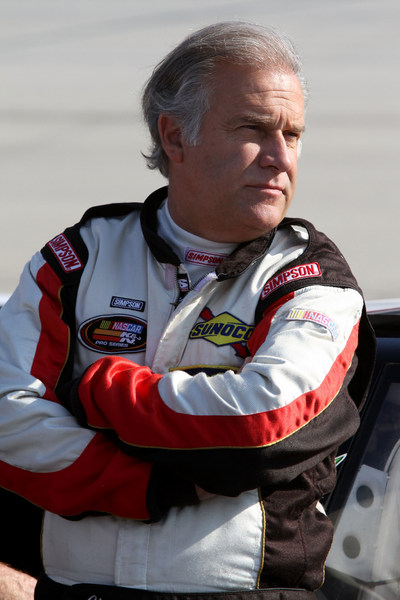
Martinsville's Clay Campbell (Photo: Getty Images for NASCAR)
But the sport charges on, and Fox TV sees enough punch in it to commit to a new $300 million a year sponsorship contract, through 2022. And it looks like NBC may want to get back into the game.
Why Fox is willing to raise its annual NASCAR sponsorship from $200 million to $300 million might seem unclear, given the sport's current slump.
Is a NASCAR Sprint Cup weekend really worth $23 million? Is that overpriced, or a bargain. Considering what TV is paying the NFL, it may well be a bargain.
(Is it still worth asking where does all this money go? Track promoters get 65 percent of it; race teams share 25 percent; NASCAR itself gets 10 percent, in a formula that hasn't changed in decades.)
For some comparison, Fox, NBC and CBS will pay the National Football League $3.1 billion a year for 2014-2022, and ESPN will pay the NFL $1.9 billion a year for its new eight-year contract. Adding all the other bits and pieces, the NFL will be getting some $6 billion a year from TV...which means, averaging things, an NFL TV weekend is worth about $300 million.
(Fox alone will be paying the NFL $1.1 billion a year in the new contract; that's about $55 million for its part of an NFL weekend.)
TV has changed NASCAR. For better, and for worse too perhaps.... (Photo: Getty Images for NASCAR)
TV has changed the sport of NASCAR racing in the days since the big new TV package was first launched in 2001.
But it looks like it's been a two-edged sword.
Even before this year's run of boring, the face of stock car racing was changing.
During the sport's meteoric rise in the late 1990s and early 2000s, promoters couldn't build seats fast enough.
The high-water mark may have been 2005-2006.
Since 2007 something big appears to have changed.
The sport began slipping, losing fans. Perhaps even losing its cachet?
That was before the economy went south.
What has happened over the last five or six years?
Maybe TV has changed this sport just a little too much. Made too many people too lazy for too long, and lately it's finally caught up with the sport.
Many in the new breed of NASCAR promoters are, generally, quite different from the old breed. Maybe TV's money has changed some of that dynamic.
Remember when NASCAR promoters were almost bigger than life. Men like Martinsville's Clay Earles, Richmond's Paul Sawyer, North Wilkesboro's Enoch Staley, Charlotte's Humpy Wheeler and Bruton Smith, Riverside's Les Richter....and of course Big Bill France, who once expressed his displeasure with drivers boycotting his Talladega track by jumping in a race car himself and ripped off some laps at speed.
Once NASCAR promoters were almost a show in themselves. And which one was it who invited Jimmy the Flying Greek to launch a school bus, a la Evel Knievel -- at tiny Bristol?
Texas' Gossage may be one of the few throwbacks, a man considers the outrageous just another day at the office.
Even Bruton Smith has slowed down. It's been four months since he last 'held court,' as judge-jury-and-executioner, in his inimitable style.
Maybe it's time for ol' Bruton to weigh in on the state of this sport, and what he'd do to spark things.
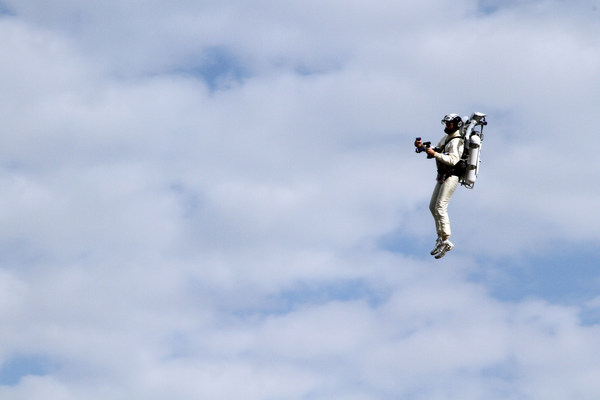
Bruton Smith jets into one of his race tracks. No, not really. Just another promotion (Photo: Getty Images for NASCAR)
What's it like being a big league stock car racing promoter these days?
Not quite like the days when Tim Flock would park his car Sunday mornings in any one of the sport's track parking lots, a car literally plastered with Charlotte tickets.
Martinsville Campbell, grandson of the amazing Clay Earles (whose showdowns with the Frances are old-school legend), was literally born into this sport. His NASCAR roots go deeper than most of today's current crop of promoters.
"It's certainly a challenge, compared to what it used to be," Campbell says.
"Back 20 years ago anybody could have done it: if you build it, they'll come.
"But then the economy went south on us...and it makes us all have to think outside the box, get creative.
"You really have to put forth a lot of effort. We're probably doing more now for less.
"But now at Martinsville I don't think we've really changed much. We've always done it the old-fashioned way. Go out and beat the drum."
Phoenix' Brian Sperber (L) and Trevor Bayne. First sellout of the season? (Photo: Getty Images for NASCAR)
This season the stock car racing world has been hit with a bad dose of boring.
Too much green flag racing.
Like those last 200 miles at Charlotte the other day, which went caution-free, putting drivers into fuel-saving mode for more than an hour.
Even Talladega wasn't immune.
Blame it on whatever you want to -- so many gas-mileage finishes, with 'featherfoot' racing....the bizarre 'wave-around' rule...ever-faster speeds that accentuate all those aerodynamic issues...continued loss of big sponsors, either driven away or priced out...maddening, even emasculating, pressure on drivers and car owners to be politically correct...the continuing marketing push around a weekly 30th-place finisher who happens to have sex appeal...Friday qualifying that is totally meaningless, and which plays out to empty, echoing stands....
Maybe part of the problem is -- like in Formula 1, as addressed HERE -- this sport's new asphalt compounds. Maybe rougher aggregate, like at Atlanta and Rockingham, would make for better racing.
And a major issue, which NASCAR and its promoters have generally failed to address, is the exorbitant cost of hotel rooms on race weekends. The powers that run this sport are open to sharp criticism for failing to address hotel costs, which are a big factor in a family's decision to go or not to go to a Sprint Cup race.
The late Jeff Byrd, Bristol promoter, once suggested the sport's officials use their considerable political clout to get anti-gouging laws passed. However nothing ever came of that.
Without decent hotels at reasonable prices within reasonable driving distance of the track, promoters could be giving tickets away for free and still have trouble filling the stands.
Empty stands on Fridays? "There's really no reason (for fans to show up), because all we're doing on Fridays is reshuffling the deck," Campbell says. "You know the cards that are going to be played.
"Fans have no interest in that.
"...but Fridays used to be a big day for us, huge....
"But Sundays these days are tough enough for us. If your Sunday's aren't what they were 10 or 15 years ago, then neither are your Fridays."
Hey, why not something different than single-lap runs? Like heat races. Works at Daytona in February.
"I'd love to see it, and I know the fans would love to see it," Campbell says. "I don't know how you could get the teams to buy into it, with the cost...."
Maybe if the inspection station wasn't so picky, maybe if aerodynamics wasn't so touchy, maybe then these guys could beat and bang more....
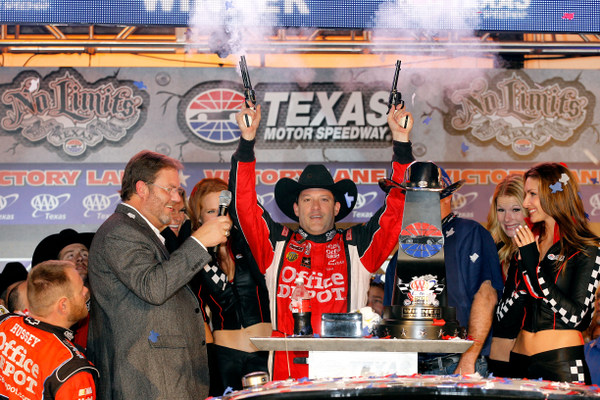
Texas' Eddie Gossage lets Tony Stewart shoot 'em up (Photo: Getty Images for NASCAR)
But the sport appears to be increasingly controlled, essentially, by the handful of team owners, who have a vested interest in the status quo...something of a stock car racing oligarchy. And Detroit car makers don't seem very interested in opening the doors to new teams either. Dodge/Chrysler execs, in fact, are pulling out of this sport, claiming they couldn't find a team they wanted to back. Too disingenuous, some might says. Simply lazy, others might say.
What that does is take a major player out of the game. And someone needs to take the blame for that: Detroit....or Daytona?
Remember NASCAR doesn't work in a vacuum. It's job is to provide a sellable product for its promoters. Lately it's not quite working.
"NASCAR gets it from all sides," Campbell says. "They get it from us, as track operators. They get it from the car owners. They get it from the drivers. They get it from the fans.
"NASCAR isn't lacking for suggestions," Campbell added wryly.
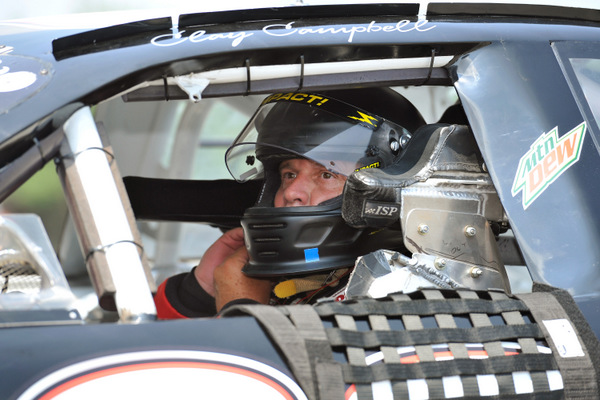
Not many NASCAR promoters put their foot down quite like Martinsville's Clay Campbell (Photo: Getty Images for NASCAR)
What happened?
Yes, the economy went south in 2008-2009, and times are still very tough in too many areas where NASCAR does business.
But something else happened too, it would seem. And it's unclear how many in the sport can really pinpoint it all.
For several years NASCAR executives tried to dismiss the dip in crowds and TV audiences.
Now, however, the slip appears to have taken on a life of its own, apart from the economic factors.
How to stop the hemorrhaging?
Is there a new demographic at work here?
Or rather are the new demographics simply not working for this sport?
NASCAR execs have targeted the so-called Gen-Y/Millennials, those born in 1983 and after. Particularly the 18-29s. Particularly males.
And, in a somewhat curious call, NASCAR execs almost seem to be dismissing the long-time core audience, which came of age in the late 1970s, 1980s and 1990s -- call them the Earnhardt generation.
Since that generation has been so hard-core, and so intrinsic to the sport, the new NASCAR marketing looks misguided.

Is NASCAR's game plan for demographics really working? What is the real demographic picture for this sport? Who watches, and who doesn't, and why? (Photo: Getty Images for NASCAR)
What is the current NASCAR demographic picture anyway? Wonder why sports' officials and TV bosses aren't laying out the demographics for this sports world to see...and judge?
Perhaps some major league baseball stats are relevant here: that sport appears to be drawing more 50+ women than 18-29 males.
What might be the corresponding stats for NASCAR racing?
This sport appears to be still struggling to attract the classic sports demographic, 18-34 males.
TV execs say that demo has been down 20 percent this year.
One NASCAR exec insists that demographic is just "fickle," whatever that means. It certainly wasn't very 'fickle' for years...until something happened.
One curious issue here is that this Gen-Y seems less enthusiastic about or interested in America's once-renowned 'car culture.'
It's a big issue for Detroit too, not just on NASCAR Sundays but on Mondays and Tuesdays.
Can Detroit count on NASCAR to help renew interest in street cars?
Certainly not if this season's Sunday action is part of that game.
"We haven't had that brand identity, and I think the manufacturers are going to be really pleased with the 2013 car," Campbell says. "And the fans will be pleased too -- they will see a race car and not just emblem on the hood, and go to the dealer and see one.
"I think that will bring some excitement back to the sport that we haven't had for a while...with all the cars looking the same."
That 2013 project, of course, is a direct swipe at the long-criticized 'car-of-tomorrow,' a matching-template model that debuted in 2007.
How much has NASCAR learned from the problems of that COT?
One issue to keep an eye on -- lightweight parts, carbon fiber pieces. Expensive. And perhaps too many 'proprietary' parts. Competition usually makes for cheaper prices....
To make the COT even raceable, teams had to come up with weight-cutting parts, to lower the center of gravity. And those weight-cutting parts, and the development process to cut weight, has become a major expense for team owners. There are indications the 2013 may have much of that same downside.
"I don't think there is a silver bullet that will fix the problems we have," Campbell says.
"NASCAR has a tough task to get our product where it needs to be....to get the fans in the stands, to get the people watching on TV, really interested in it. And I think they're making good strides at it.
"Our teams realize it, the drivers realize it....
"If we don't have people interested in what we've got -- fans -- that relates to sponsorship. And if we don't have fans watching it, sponsors don't want to be a part of it.
"Fans are our key. We've got to provide them what they want.
"Fortunately at Martinsville we pretty much do that. But in general NASCAR's got it tough.
"But they're trying.
"Everybody realizes it.
"If anybody had that magic bullet, we'd fix it.
"But there are numerous contributing factors.
"Back in the Junior Johnson days (say, 1972 to 1992) you had maybe half a dozen teams that were cream of the crop. And then you had the mid-pack....
"You look at our fields here today, there are no slouches. They are all good teams, all good cars.
"The separation from the pole to last place is miniscule.
"And the reliability is amazing; you just don't have the mechanical issues you used to have.
"That's a big factor.
"What can you do about it? I don't know. But I know it's a concern of everybody's.
"If we can get the racing to where it needs to be, to what the fans want to see...
"It's an uphill battle, but I think everyone is rowing in the same direction, trying to fix it."
Hopefully.
Because it's looking like too many fans are voting with their feet and their TV remotes.
It may all beg for some leadership with a new vision for this sport, on both the competition side and on the marketing side.
NASCAR's TV command center (Photo: Getty Images for NASCAR)
© 2010-2011 www.mikemulhern.net All rights reserved.
Web site by www.webdesigncarolinas.com







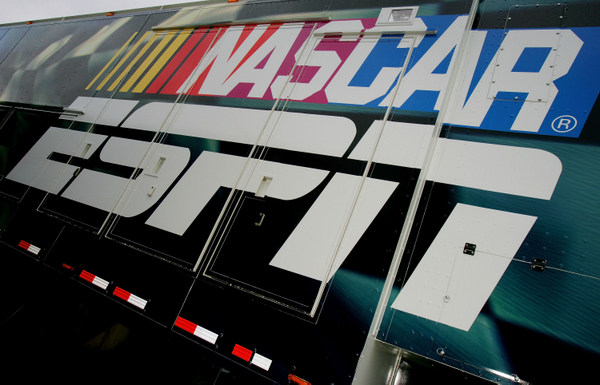
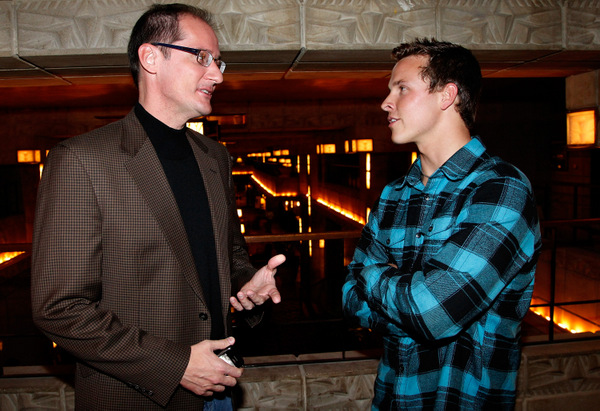
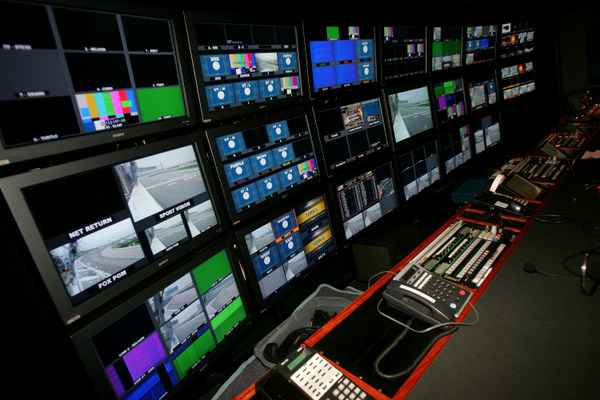
The CoT was a mistake, the Chase is a mistake,
The CoT was a mistake, the Chase is a mistake, the schedule is stale. Giving California and Kansas second dtaes was a mistake. We need more \"action\" tracks like Road America and Iowa. All these 1.5 milers produce boring racing. The cost of attending a race just isn\'t worth it anymore after years of \"overspending\" to go to a race. Being crammed in to 18 inch seats isn\'t worth it anymore. $1000.00 buys a damn good TV these days.
My NASCAR boom period was in the 80's and
My NASCAR boom period was in the 80\'s and 90\'s.home track Pocono. Friday crowd was helped by both races in summer, so no school meant more kids could go, heavily promoted 2 for 1 admissions by race sponsors and track, It was a cheap day to be introduced to the sport,less crowds,usually 45+ cars to qualify(with the question of who would need 2nd day Qual. on Sat. to make the show),souvenirs that then you could only get at track, not online or at every store.
Then for the weekend a gang of us in our 20\'s and 30\'s would rent a Ryder truck and camp out at Pocono. Arrive Sat late afternoon,park,set up our truck for Sunday watching, then relax and party.Was it rowdy, yeah a bit. But they decided we were a bad element and blocked the view and went to the motorhome only era.But us rowdy 20\'s became fans in our 30\'s, bought the good seats, led me to attending 7 races in a season at my peak,went to 9 different cup and 2 different Busch tracks. So now ,IMHO, opinion,the chance to develop younger fans is limited.Find a Pocono pic from the late 80\'s, look at how full the turn one and backstraight area was with vehicles then, and look at a 200\'s era view. There is where your future paying fans come from.
One other thing here in the Northeast at least, before we had dumpy pro sports stadiums around here. Now you have state of the art new facilities in DC, Baltimore, Philly, even classy minor league baseball stadiums all after the same sport $.For the average fan do you choose that, or the erector set, hard to navigate, water dripping through seats as you walk under them racetrack.
It was long and rambling, but this something that has bugged me for years, so i vented, thx
Too much green flag racing? What does that mean?
Too much green flag racing? What does that mean? Too much green flag parades, more like it. Make the points structure about winning, dump the Chase. Everything else is a joke.
simple -- RJR _was_ the marketing force nascar
simple -- RJR _was_ the marketing force nascar itself thought it was.
and the tv money with fox is skewed due to their getting speed to do what they will with and nascar\'s internet rights. you\'re comparing apples and oranges my man.
Mike,You always see the bad side of
Mike,
You always see the bad side of everything. The attendance issue has little to do with NASCAR in And of itself. ALL major sports leagues are having lowered attendance. The Yankee's playoff games in New York did not sell out for example. The fact is that as a society we are becoming more and more satisfied with watching the game on tv from our couch. That coupled with a soured economy does not project well for event attendance now or into the future. Why is it that NASCAR media are the only media who talk about attendance and ratings? ill remind you NASCAR continues to beat MLB MLS NHL and most Nba games on a regular basis in both categories. Here's an idea. Instead of fabricating negative stories, why not talk about a 2 point championship or a season that has brought us unparalleled parity and competition?
Cost cutting
If NASCAR wants to bring back the "glory days," maybe they could put in requirements that are based on those such as having the cars require parts that are actually stock. If NASCAR required parts to be only of a certain material, they could control costs against special metals to reduce weight. Last thing, I would love the end of the chase.
Just a thought. After reading an article
Just a thought.
After reading an article addressing the “state of NASCAR” , I got to thinking about the changes, good and bad to the sport I love most. The article addressed the attendance, the racing, the demographics, TV, etc.
Putting on a NASCAR race takes more than “chump” change. At the same time, if a promoter is lucky enough to get a Cup race, they can almost “make” their year. Look at the tracks that only have 1 or 2 races per year, Michigan, California, Pocono to name a few. Granted, this is not the only activity. But test are paid in full by the teams that utilize them. Tracks like Martinsville host events that we seldom if ever hear about. Car shows, Kart and Legend car racing, etc. Promoting is still a full time job.
The promoters are still making money. For the most part TV, event sponsors, contingency sponsors, and the teams pay the purse for the event. The attendance is the bread and butter for the promoter. A lower ticket price and full stands will yield more margin than high ticket prices and 2/3 of the stands full. Even at “general” ticket pricing.
Most restaurants do not raise prices for the race week-end. Motels do. The cost of a room goes through the roof as these folks try to “make” their year. NASCAR and the promoters owe it to the fans to work with the lodging in a 20 to 50 mile radius of the track. Folks that want to lodge within 19 miles of the track can pay for the convenience. And a 5 day minimum is absurd. Real folks work M – F and would leave Thursday afternoon/evening, take Friday and Monday off, drive home Monday. Making a 3 day minimum more reasonable. Again, a full motel at a lower rate is more profitable than empty rooms at a higher rate.
The NASCAR product
The COT (Car of Tomorrow) has and is a double edge sword.
Pros: It has enhanced driver safety beyond what was ever imagined. NASCAR should be heralded as the ultimate leader in the safety and concern of its participants, both on the track and in the stands. No other sport, (NFL and NHL comes to mind) has made changes to protect the participant without changing the product.
Fuel injection has been needed for several years. It opens the doors for other makes to come into NASCAR. Honda refused years ago because they did not and would not make a “normally aspirated” engine. Kia is beginning to dabble in motorsports also. Toyota knocked down the “Detroit” door. It is time for other auto makers to come in and join the party.
Bias ply tires went away and made the driver “drive”.
Cons: Decals and side windows do not make a Camry, Impala, Charger, or Fusion. And most fans don’t even know the side windows differentiate the makes. They all look alike stripped of their paint.
Aero is a bane. A 2 inch spoiler on the back, a 2 inch spoiler on the front with 3 inch ground clearance will equalize the cars, but not the drivers. I am sure that what we have is safer, or at least the argument. Aero push limits passing and hinders racing. Catching a leading car is not worth much if you can’t pass.
Radial tires don’t give up the feel that Bias ply tires did.
Tracks make or break the racing.
Tracks like Martinsville, Bristol, and Richmond are packed for every race. Wonder why? Tracks like Michigan and California have struggled for years. Fans want to see close racing. A little beating and banging goes along way to filling the stands. There is a place for Talladega and Daytona on the schedule, but do we need so many 1.5 mile tracks? The drivers will tell you that Chicagoland and Kansas are different. Will the fans? Are Texas, Charlotte, and Atlanta different? Not to the naked eye of the fan. Atlanta at one time was the only true oval on the NASCAR circuit. A distinguishable trait that should have been embraced and promoted much like the “Lady in Black” (Darlington).
The NASCAR show
Reliability in equipment has equalized the haves and have-nots. It has also lowered the number of caution laps in most cases. There are more teams with quality equipment than ever before. And even though there are those you know will run up front, more teams than ever, maybe 30, could win. Blown engines are almost a thing of the past. Mechanical failures, through the thoroughness and quality checks of teams, are less. Cars finishing on the lead lap and just finishing are up (though part is manipulated, more later). Personally less yellow laps/more green laps are a good thing. A race is who can get from point A to point B the fastest. Pushing the envelope will cause yellows when drivers cross that line. Elimination of aero will broaden that line.
Pit road speed limits are a necessary evil. Again a two edge sword. Safety outweighs any argument of doing it any other way. Under yellow flag conditions, when a majority of cars are pitting, there is NO other way. Too many cars and too many chances for injury. However, could green flag stops be adjusted? Maybe double the yellow flag limit. A green flag stop followed by an “untimely” yellow can and has decided a race. Being caught a lap or 2 down in this manner is not racing but “luck”. At a track like Bristol or Martinsville a car would still lose a lap or 2 but at Atlanta or Charlotte, maybe none.
Aaron’s, the official sponsor of NASCAR, loves the “Lucky Dog”, but it has run its course. When restarts had lapped cars to the inside it rewarded a driver, maybe one getting caught a lap down, by giving a lap back. A gimmick that was just that, a gimmick. The “wave around” rule is a product of the double file restarts. One of the best racing decisions NASCAR has ever made. The double file restart puts the racing back, truly bunching up the field. What really makes sense of the wave around is that it is a risk/reward situation. If a team chooses to forego a pit stop under yellow they can get a lap back. The risk is that they won’t get a yellow before needing to pit, putting them a lap down again. The reward is that they will get a yellow enabling them to keep the lap they made up.
Fuel mileage races are what they are. It is part of the strategy that has become part of the race. That being said, if NASCAR wanted to change it they could mandate different size fuel cells for different tracks. Either by going to a larger 22 gallon fuel cell at Daytona and Talladega or a 13 gallon fuel cell at Richmond or Charlotte, you get the idea.
Deciding a Champion
No matter the point system you have, it will always be consistency that prevails. It is just a mathematical fact.
When the Chase first became the plan it was scoffed at by many. In some cases and rightfully so. It is human nature to dislike change. The “tweeks” made it look like a gimmick. To call it a play-off is just plain a bad analogy. A play-off includes eliminations and somehow 400 miles at Homestead with only 2 or 3 cars just doesn’t seem interesting. NASCAR needs 43 cars at each race. Actually, they could get by with less but for our example they use 43.
My suggestion is as follows:
Utilize the current point system during the first 26 races.
At the end of 26 races, the point leader, any team with a win, and the 2 teams with the most points but no wins qualify for the chase.
No points are awarded after 26 races.
The Chase tracks would be made up of: one ½ mile (Martinsville, Bristol), one ¾ mile (Richmond, Iowa?), one 1 mile (Dover, Phoenix, New Hampshire), one 1 ½ mile (Charlotte, Texas, Atlanta, Kansas, Chicago, Vegas), one road course (Watkins Glen, Sonoma), one super speedway (Daytona, Talladega), Darlington, one 2 mile California, Michigan), one 2 ½ mile (Indianapolis, Pocono), and one track drawn at random at the previous banquet.
The Champion would be determined by the chaser with the most wins in the chase. Tie-breaker being seconds, thirds, etc. In the event no chaser wins, average finish throughout the chase.
IN MY OPINION
OK, I see a multi pronged problem, and yes I do hate B.Z.F....
1. The problem with sponsors, started when BZF showed his Dad how much more money the company could make on marketing NA$CAR sponsorships and started taking sponsors from the teams.
2. Then you have his attempt to lock down the collector car market. What a nightmare that turned out to be for us 1/24 scale autograph collectors.
3. Let us not forget the cost of camping at the tracks. My father was on an oxygen machine, and since generators have to be turned off at night, we had to get a spot with power hook-up $500.00 at Bristol.. At Atlanta
the summer before our quite generator had the gas line cut, pull cord cut off and beer put in the gas tank.
4. The cost of gas has doubled in the last four years, making driving an 8 mpg camper insane, unless your independantly wealthy, which we aint.
5. Then you used to have access to drivers for autographs on Fridays, Saturdays and early Sunday. Now you stand in line get a ticket if your lucky to be in the first 100 at 7am Sunday and you might get 1 1/24 car autographed, if you buy it from that sales trailer.
6. Remember Wider is Better the old Pontiac slogan. COT killed such things, and took away the win on sunday sell on monday.
7. We need to go back to the smaller teams, limit the owners to 2 cars, these multi car stables are killing the sport, lets get back to the motor companies providing the engines, and and such to level the playing fields.
I know long winded, but I needed to vent.
Post new comment